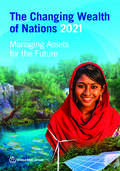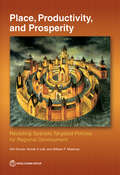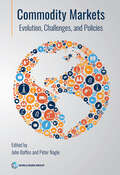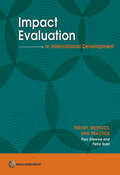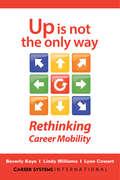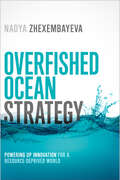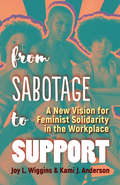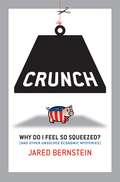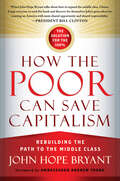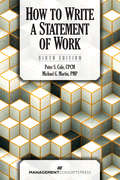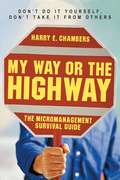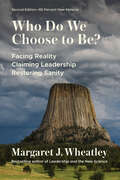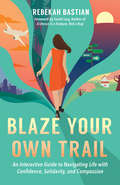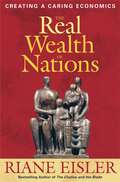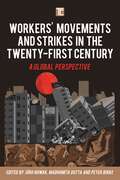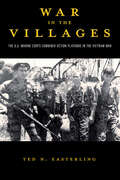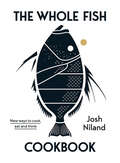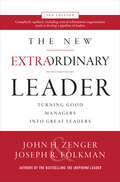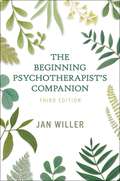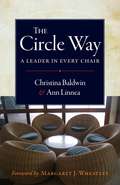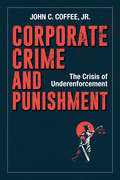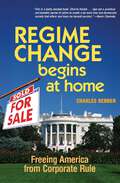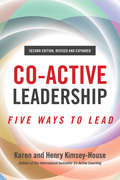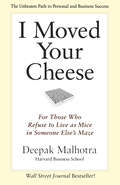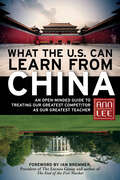- Table View
- List View
The Changing Wealth of Nations 2021: Managing Assets for the Future
by World BankIt is now clear that a narrow focus on the growth of gross domestic product (GDP) is insufficient to achieve humanity's aspirations for sustainable prosperity. Well-functioning ecosystems and educated populations are requisites for sustainable well-being. These and other too-often-neglected ingredients of national wealth must be addressed if the development path is to be sustainable. 'The Changing Wealth of Nations 2021: Managing Assets for the Future' provides the most comprehensive accounting of the wealth of nations, an in-depth analysis of the evolution of wealth, and pathways to build wealth for the future. This report--and the accompanying global database--firmly establishes comprehensive wealth as a measure of sustainability and a key component of country analytics. It expands the coverage of wealth accounts and improves our understanding of the quality of all assets, notably, natural capital. Wealth--the stock of produced, natural, and human capital--is measured as the sum of assets that yield a stream of benefits over time. Changes in the wealth of nations matter because they reflect the change in countries' assets that underpin future income. Countries regularly track GDP as an indicator of their economic progress, but not wealth, and national wealth has a more direct and long-term impact on people's lives. This report provides a new set of tools and analysis to help policy makers navigate risks and to guide collective action. Wealth accounts can be applied in macroeconomic analysis to areas of major policy concern such as climate change and natural resource management. This report can be used to look beyond GDP, to gauge nations' economic well-being, and to promote sustainable prosperity.
Place, Productivity, and Prosperity: Revisiting Spatially Targeted Policies for Regional Development
by Arti Grover Somik Lall William MaloneyPlace matters for productivity and prosperity. Myriad factors support a successful place, including not only the hard infrastructure such as roads, but also the softer elements such as worker skills, entrepreneurial ability, and well-functioning institutions. History suggests that prosperous places tend to persist, while “left-behind†? regions—or those hurt by climatic, technological, or commercial shocks—struggle to catch up. This division gives rise to demands to “do something†? about the subsequent spatial inequality. Such pressures often result in costly spatially targeted policies with disappointing outcomes because of a lack of analysis of the underlying barriers to growth and structural transformation and a fair appraisal of the possibility of overcoming them. The latest volume of the World Bank Productivity Project series, Place, Productivity, and Prosperity: Revisiting Spatially Targeted Policies for Regional Development makes three broad contributions. First, it provides new analytical and empirical insights into the three drivers of economic geography—agglomeration economies, migration, and distance—and the way in which these drivers interact. Second, it argues that these forces are playing out differently in developing countries than they have in advanced economies: urbanization is not accompanied by structural transformation, leaving cities crowded and accruing all the negative aspects of urbanization without being concentrated productively. Long-term amelioration of poverty in lagging regions requires advancing the overall national agenda of structural change and productivity growth. Third, it provides a heuristic framework with which to inform policy makers’ assessments of place-based policy proposals, helping them identify the regions where policy is likely to have an impact and those that would remain nonviable. The framework enables governments to clarify the implications of various policy options; to think critically about design priorities, including necessary complementary policies; and to navigate the implementation challenges. “This is an extremely welcome book. Three experts lay out the principles behind spatially targeted policy and the experience of countries using such policies. A must-read for anyone interested in spatial inequality and policy to address it.†? Anthony J. Venables Professor of Economics, University of Manchester, and Research Director, The Productivity Institute “Delivering better livelihoods for all requires tapping into the economic potential of every place, including those losing out or lagging behind. This, however, cannot be done effectively without a sound theoretical and empirical framework. Place, Productivity, and Prosperity is the right book to look for such a framework.†? Andrés Rodríguez-Pose Princesa de Asturias Chair and Professor of Economic Geography, London School of Economics
Commodity Markets: Evolution, Challenges, and Policies
by Peter Nagle John BaffesCommodity markets are integral to the global economy. Understanding what drives developments of these markets is critical to the design of policy frameworks that facilitate the economic objectives of sustainable growth, inflation stability, poverty reduction, food security, and the mitigation of climate change. This study is the first comprehensive analysis examining market and policy developments for all commodity groups, including energy, metals, and agriculture, over the past century. It finds that, while the quantity of commodities consumed has risen enormously, driven by population and income growth, the relative importance of commodities has shifted over time, as technological innovation created new uses for some materials and facilitated substitution among commodities. The study also shows that commodity markets are heterogeneous in terms of their drivers, price behavior, and macroeconomic impact on emerging markets and developing economies, and that the relationship between economic growth and commodity demand varies widely across countries, depending on their stage of economic development. Policy frameworks that enable countercyclical macroeconomic responses have become increasingly common—and beneficial. Other policy tools have had mixed outcomes. Discussions about commodity-exporting emerging markets are often based on ideas without empirical or analytical support. This book is a great contribution to improve our understanding of those economies, based on rigorous research. It provides robust empirical evidence including a long-term perspective on commodity prices. It also contains very thoughtful policy analysis, with implications for resilience, macroeconomic policies, and development strategies. It will be a key reference for scholars as well as policy makers. José De Gregorio Dean of the School of Economics and Business Universidad de Chile Former Minister of Economy, Mining and Energy and Former Governor of the Central Bank of Chile A sound understanding of commodity markets is more essential than ever in light of the COVID-19 pandemic, the war in Ukraine, and the transition from fossil fuels to renewable energy commodities. This volume offers an excellent, comprehensive, and very timely analysis of the wide range of factors that affect commodity markets. It carefully surveys historical and future trends in commodity supply, demand, and prices, and offers detailed policy proposals to avoid the havoc that turbulent commodity markets can cause on the economies of commodity exporters and importers. Rick Van der Ploeg Research Director of Oxford Centre for the Analysis of Resource-Rich Economies University of Oxford
Impact Evaluation in International Development: Theory, Methods, and Practice
by Paul Glewwe Petra ToddImpact evaluations are studies that attempt to measure the causal impact of a project, program, or policy on one or more outcomes. This book provides a comprehensive exposition of how to conduct impact evaluations. Part I provides an overview of impact evaluations and comprises five chapters which are accessible to readers who have few or none of the technical (statistical and econometric) skills that are needed to conduct impact evaluations. Parts II and III make use of statistical and econometric methods and are at a level similar to a graduate-student course but written to make them accessible to the ambitious reader whose skills are not at that level. Part II presents, in Chapters 6-10, a comprehensive discussion of the use of randomized controlled trials (RCTs) to conduct impact evaluations, including a general discussion of the ethical issues involved in conducting impact evaluations. Part III presents the main nonexperimental methods that are used to implement impact evaluations when RCTs are not feasible or not recommended for other reasons. Chapters 11 and 12 present regression methods, including difference-in-differences estimation. Matching methods are described in Chapter 13, after which regression discontinuity methods are covered in Chapter 14. Instrumental variable methods, including the estimation of local average treatment effects (LATE), are discussed in detail in Chapter 15. Chapters 16 and 17 cover more advanced topics: quantile treatment effects and control function methods, respectively. Part IV then considers more practical issues when conducting impact evaluations, including designing questionnaires (Chapter 18), data collection methods and survey management (Chapters 19 and 20), and disseminating results to policymakers (Chapter 21). Finally, Part V addresses two topics in impact evaluation: qualitative methods for conducting impact evaluations (Chapter 22), and cost-benefit and cost-effectiveness analysis (Chapter 23).
Up Is Not the Only Way: Rethinking Career Mobility
by Beverly Kaye Lindy Williams Lynn CowartUp Was Never for Everyone!Move up or move out. When those two options appear to be the only ones, dissatisfaction grows and engagement suffers. In decades of studying careers around the globe, Beverly Kaye, Lindy Williams, and Lynn Cowart have found that, in fact, there are more options. And rethinking career mobility can lead you to them! The authors show how managers, coaches, and employees can partner to determine what's best and what's next. Keep the same job but discover new ways to learn and grow? Explore moving to a position that could be a better fit? Step back without getting derailed? This book encourages readers to take a "kaleidoscope" view—to be open to ever-shifting patterns of opportunities and possibilities—so they can create a unique, personalized path to a truly rewarding career.
Overfished Ocean Strategy: Powering Up Innovation for a Resource-Deprived World
by Nadya ZhexembayevaWe all know the proverb about teaching someone to fish, but if there are no fish left, knowing how to catch them won&’t do you any good. And that&’s the position businesses are in today. Resources are being depleted at an alarming rate and the cost of raw materials is rising dramatically. As a result, scholar and entrepreneur Nadya Zhexembayeva says, businesses need to make resource scarcity—the overfished ocean—their primary strategic consideration, not just a concern for their &“green&” division. Overfished Ocean Strategyoffers five essential principles for innovating in this new reality. Zhexembayeva shows how businesses can find new opportunities in what were once considered useless by-products, discover resource-conserving efficiencies up and down their value chain, transfer their expertise from physical products to services, and develop ways to rapidly try out and refine these new business models. She fills the book with examples of companies that are already successfully navigating the overfished ocean, from established corporations such as BMW, Microsoft, and Puma to newcomers such as Lush, FLOOW2, and Sourcemap. The linear, throwaway economy of today—in which we extract resources at one end, create products, and throw them away at the other—is rapidly coming to an end. In every industry, creative minds are learning how to make money by taking this line and turning it into a circle. Nadya Zhexembayeva shows how you can join them and avoid being left high and dry.
From Sabotage to Support: A New Vision for Feminist Solidarity in the Workplace
by Joy L. Wiggins Kami J. AndersonWomen are acculturated within systems that encourage them to sabotage one another; this book shows how they can break free of this cultural programming and use whatever privilege and power they have to raise each other up.Joy Wiggins and Kami Anderson advocate that the only way women can successfully support each other is by addressing the varying intersections of our individual power and privileges, particularly focusing on how some privileges are inherited along lines of race, class, sexuality, and geography. When we fully examine how we have power in certain situations and not in others, we start to see where we can lend privilege to create truly inclusive spaces for the historically underrepresented and marginalized. Wiggins and Anderson look at how the dynamics of privilege and power have played out in the history of the feminist movement and identify and break down socialized behaviors and ideologies that trigger implicit bias and microaggressions. And they provide tools to interrupt negative thoughts and actions so women can nurture mutual support and show up as their authentic selves. Each chapter features a dialogue between them reflecting on how issues of race, privilege, and power have played out in their lives and their friendship.The system of patriarchy has created an environment for women to knowingly and unknowingly sabotage each other—it is not inherent in women themselves. This book teaches us how to take an active approach to becoming better allies for each other and by so doing improve our world and end the cycle of injustice.
Crunch: Why Do I Feel So Squeezed? (and Other Unsolved Economic Mysteries)
by Jared BernsteinIs Social Security really going bust, and what does that mean to me? If I hire an immigrant, am I hurting a native-born worker? Why does the stock market go up when employment declines? Should I give that homeless guy a buck? What’s a “living wage”? How much can presidents really affect economic outcomes? What does the Federal Reserve Bank really do? And even when some pundits say the economy’s sound, why do I still feel so squeezed? If you’d like some straight answers, premier economist Jared Bernstein is here to help. In Crunch he responds to dozens of questions he has fielded from working Americans, questions that directly relate to the bottom-line, dollars-and-cents concerns of real people. Chances are if there’s a stumper you’ve always wanted to ask an economist, it’s solved in this book. Bernstein is fed up with “Darth Vaders with PhDs” who use their supposed expertise to intimidate average citizens and turn economics into a tool for the rich and powerful. In the pages of Crunch, Bernstein lays bare the dark secret of economics: it’s not an objective scientific discipline. It’s a set of decisions about the best way to organize our society to produce and distribute resources and opportunities. And we all can, and must, participate in these decisions. “America is a democracy,” he writes. “And in a democracy all of us, not just the elites and their scholarly shock troops, get to weigh in on biggies like this.” To not weigh in, Bernstein insists, is a profoundly political act, one with damaging consequences. Our economy will be only as fair as we can make it. In this lively and irreverent tour through everyday economic mysteries, Bernstein helps us decode economic “analysis,” navigate through murky ethical quandaries, and make sound economicdecisions that reflect our deepest aspirations for ourselves, our families, and our country.
How the Poor Can Save Capitalism: Rebuilding the Path to the Middle Class
by John Hope BryantJohn Hope Bryant, successful self-made businessman and founder of the nonprofit Operation HOPE, says business and political leaders are ignoring the one force that could truly re-energize the stalled American economy: the poor. If we give poor communities the right tools, policies, and inspiration, he argues, they will be able to lift themselves up into the middle class and become a new generation of customers and entrepreneurs. Raised in poverty-stricken, gang-infested South Central Los Angeles, Bryant saw firsthand how our institutions have abandoned the poor. He details how business loans, home loans, and financial investments have vanished from their communities. After decades of deprivation, the poor lack bank accounts, decent credit scores, and any real firsthand experience of how a healthy free enterprise system functions. Bryant radically redefines the meaning of poverty and wealth. (It's not just a question of finances; it's values too.) He exposes why attempts to aid the poor so far have fallen short and offers a way forward: the HOPE Plan, a series of straightforward, actionable steps to build financial literacy and expand opportunity so that the poor can join the middle class. Fully 70 percent of the American economy is driven by consumer spending, but more and more people have too much month at the end of their money. John Hope Bryant aspires to "expand the philosophy of free enterprise to include all of God's children" and create a thriving economy that works not just for the 1 percent or even the 99 percent but for the 100 percent. This is a free enterprise approach to solving the problem of poverty and raising up a new America.
How to Write a Statement of Work
by Michael G. Martin PMP Peter S. Cole CPCMThe standard on government statements of work just got better!How to Write a Statement of Work has been a standard reference for government employees and contractors for many years. Now, with this sixth edition, it is even more relevant and useful. Based on the excellent foundation laid by the late Peter Cole, Michael Martin has updated and added material to guarantee this handbook's place in the list of "must haves" for working with government contracts. As in the earlier editions, the emphasis is on providing practical, detailed guidance on writing and preparing a description of government requirements, whether a statement of work (SOW), a performance work statement (PWS), or a statement of objectives (SOO).Among the many additions to this sixth edition are updates to reflect the current definition of an SOO as well as references and guidance regarding the development and application of the SOO. There is a new chapter on why change management is so important on projects, legal precedents supporting change management, and how to identify when a change occurs using the SOW. This new chapter also includes information on the federal government's Standard Form 30 (SF30) to provide perspective on how change orders are used and applied in the federal government. If you are working in government contracting in any capacity, you should have this book on hand!
My Way or the Highway: The Micromanagement Survival Guide
by Harry E. ChambersBy the author of the bestselling Bad Attitude Survival Guide (more than 40,000 copies sold), named one of the top business books of 1998 by Executive Book Summaries Everyone thinks they know what micromanagement is, but this book presents a specific, detailed definition illustrated with concrete examples Offers successful strategies for overcoming your own micromanaging behavior and for responding when you are being micromanaged Micromanagement is one of the most widely condemned managerial sins, and one of the most common employee complaints. It results in significant direct, indirect, and hidden costs to organizations, contributing to low morale, high turnover, inefficiency, instability, and lack of continuity. And being perceived as a micromanager can have a significant negative impact on your career. But what, precisely, is micromanagement? More importantly, what can be done about it? In My Way or the Highway, Harry Chambers proves that micromanagement can be objectively identified and successfully resisted, both by those who (often unknowingly) inflict it and by those who are its victims. In an informal, entertaining style Chambers describes five specific defining traits of micromanagers: placing their own self interest above everything else; controlling and manipulating time; attempting to determine exactly how everything must be done; requiring elaborate approval processes; and establishing dysfunctional monitoring and reporting requirements. He even provides a Micromanagement Potential Indicator test so you can see whether (and to what extent) you might be a micromanager. He then devotes a chapter to each trait, providing real-world examples of the trait in action and an analysis of the damage it does. But this is not just a book of diagnosis-Chambers provides treatment as well. He devotes several chapters how to respond if you are the micromanagee (a victim of micromanagement), how to eliminate your own micromanaging behaviors, and what to do if you have to manage a micromanager. Avoiding micromanagement should be a major goal of every manager, would-be manager, team member, or collaborative peer. My Way or the Highway offers detailed, actionable, field-tested strategies that will eliminate the damage that overcontrolling behavior causes and increase creativity, risk-taking, productivity, and initiative in any organization.
Who Do We Choose to Be?, Second Edition: Facing Reality, Claiming Leadership, Restoring Sanity
by Margaret J. WheatleyIn a world we cannot recognize, how do we find a way forward? In this world we do not understand, how do we know what to do? When so little is comprehensible, what is meaningful work? What is genuine contribution?Bestselling author Margaret Wheatley has summoned us to be courageous leaders who strengthen community and rely on fully engaged people since her 1992 classic book, Leadership and the New Science, and eight subsequent books. In response to how quickly society is changing and the exponential increase in leadership challenges, this second edition of her latest bestseller is 80% new material.How do we see clearly so that we can act wisely? Wheatley brings present reality into clear and troubling focus using multiple lenses of Western and Indigenous sciences, and the historic patterns of collapse in complex civilizations. With gentle but insistent guidance to face reality, she offers us the path and practices to be sane leaders who know how to evoke people's inherent generosity, creativity, and kindness.Skillfully weaving science, history, exemplars, poetry, and quotes with stories and practices, Wheatley asks us to be Warriors for the Human Spirit, leaders and citizens who stay engaged, choose service over self, stand steadfast in the midst of crises, and offer our reliable presence of compassion and insight no matter what.
Blaze Your Own Trail: An Interactive Guide to Navigating Life with Confidence, Solidarity, and Compassion
by Rebekah BastianA modern, feminist take on the classic choose-your-own-journey book, inspiring readers to embrace the fact that there is no singular right path—just your own! So many women enter their adult lives believing that they should know where they are going and how to get there. This can make life decisions feel intimidating and overwhelming. While some choices that lie ahead are fairly predictable, such as those surrounding career, partnership, and motherhood, the effects of these choices can lead to more complicated and unexpected turns that are seldom discussed.Rather than suggesting a rule book, Rebekah Bastian, vice president at Zillow and recognized thought leader, inspires you to Blaze Your Own Trail. "I have the benefit of being a living example of crooked paths, magnificent screw-ups, and shocking successes," she writes. Through storylines and supportive data that explore workplace sexism, career changes, marriage, child-rearing, existential crises, and everything in between, you will learn to embrace and feel less alone in your own nonlinear journey. Even better, you can turn back decisions and make different ones. Blaze Your Own Trail includes nineteen possible outcomes and many routes to get there. You will find that you have the strength to make it through any of them.
The Real Wealth of Nations: Creating a Caring Economics (Bk. Currents Ser.)
by Riane EislerAdam Smith's The Wealth of Nations provided the first, most influential and lasting explanation of the workings of modern economics. But with his focus on "the market" as the best mechanism for producing and distributing the necessities of life, Smith's concepts only told part of the story, leading to flawed economic models that devalue activities that fall outside of the market's parameters of buying and selling. The real wealth of nations, Riane Eisler argues, is not merely financial, but includes the contributions of people and our natural environment. Here, Eisler goes beyond the market to reexamine economics from a larger perspective--and shows that we must give visibility and value to the socially and economically essential work of caring for people and the planet if we are to meet the enormous challenges we are facing. Eisler proposes a new "caring economics" that takes into account the full spectrum of economic activities--from the life--sustaining activities of the household, to the life-enriching activities of caregivers and communities, to the life-supporting processes of nature. She shows how our values are distorted by the economic double standard that devalues anything stereotypically associated with women and femininity; reveals how current economic models are based on a deep-seated culture of domination; and shows how human needs would be better served by economic models based on caring. Most importantly, she provides practical proposals for new economic inventions--new measures, policies, rules, and practices--to bring about a caring economics that fulfills human needs. Like her classic The Chalice and the Blade, The Real Wealth of Nations is a bold and insightful look at how to create a society in which each of us can achieve the full measure of our humanity.
Workers’ Movements and Strikes in the Twenty-First Century: A Global Perspective (Transforming Capitalism)
by Jörg Nowak Madhumita Dutta Peter BirkeWhile workers movements have been largely phased out and considered out-dated in most parts of the world during the 1990s, the 21st century has seen a surge in new and unprecedented forms of strikes and workers organisations. <P><P> The collection of essays in this book, spanning countries across global South and North, provides an account of strikes and working class resistance in the 21st century. Through original case studies, the book looks at the various shades of workers’ movements, analysing different forms of popular organisation as responses to new social and economic conditions, such as restructuring of work and new areas of investment.
War in the Villages: The U.S. Marine Corps Combined Action Platoons in the Vietnam War
by Ted N. EasterlingMuch of the history written about the Vietnam War overlooks the U.S. Marine Corps Combined Action Platoons. These CAPs lived in the Vietnamese villages, with the difficult and dangerous mission of defending the villages from both the National Liberation Front guerrillas and the soldiers of the North Vietnamese Army. The CAPs also worked to improve living conditions by helping the people with projects, such as building schools, bridges, and irrigation systems for their fields. In War in the Villages, Ted Easterling examines how well the CAPs performed as a counterinsurgency method, how the Marines adjusted to life in the Vietnamese villages, and how they worked to accomplish their mission. The CAPs generally performed their counterinsurgency role well, but they were hampered by factors beyond their control. Most important was the conflict between the Army and the Marine Corps over an appropriate strategy for the Vietnam War, along with weakness of the government of the Republic of South Vietnam and the strategic and the tactical ability of the North Vietnamese Army. War in the Villages helps to explain how and why this potential was realized and squandered. Marines who served in the CAPs served honorably in difficult circumstances. Most of these Marines believed they were helping the people of South Vietnam, and they served superbly. The failure to end the war more favorably was no fault of theirs.
The Whole Fish Cookbook: New Ways to Cook, Eat and Think
by Josh NilandIn The Whole Fish Cookbook, groundbreaking seafood chef Josh Niland reveals a completely new way to think about all aspects of fish cookery. From sourcing and butchering to dry ageing and curing, it challenges everything we thought we knew about the subject and invites readers to see fish for what it really is - an amazing, complex source of protein that can and should be treated with exactly the same nose-to-tail reverence as meat. It features more than 60 recipes for dozens of fish species ranging from Smoked Marlin Ham Caesar Salad, Fish Cassoulet and Roast Fish Bone Marrow to - essentially - The Perfect Fish and Chips. Many of us would like to eat more fish but worry about the environmental impact and often end up cooking the same old salmon fillet on repeat. The Whole Fish Cookbook will soon have you embracing new types and will change the way you buy, cook and eat fish. <P><P> There is so much more to a fish than just the fillet, and it is indeed true what they say about there being more than just a handful of fish in the sea.
The New Extraordinary Leader: Turning Good Managers into Great Leaders
by John H. Zenger and Joseph R. FolkmanThe classic for managers seeking to hone their leadership skills into a C-Suite position <P><P> Updated with copious new research conducted over the past ten years, this landmark work provides everything you need to transform yourself from an effective manager to an extraordinary leader. <P><P> In addition to the time-proven methods and approaches that has made The New Extraordinary Leader one of the most popular leadership books around, this third edition includes <ul> <li>Updated insights on how to demystify leadership</li> <li>More data on how extraordinary leadership directly benefits employee engagement, customer satisfaction, retention, innovation, and profitability</li> <li>A brand-new, simplified definition of leadership strengths</li> <li>Critical research on the importance of developing leadership teams</li> <li>Three all new chapters that cover: Leadership competencies and how they interplay with each other, The role of cross training in leadership development, and The leader’s role in his or her own development</li></ul>
The Beginning Psychotherapist’s Companion
by Jan WillerWith a reassuring and clear writing style, this third edition of The Beginning Psychotherapist's Companion offers practical suggestions and clinical examples to address the professional development and emotional concerns of the beginning psychotherapist. Guidance is provided on managing readers' relationships with their supervisors and diverse clients; the book also educates readers on managing their personal well-being, and discusses the foundations of ethical practice, including informed consent, confidentiality, and documentation. Extensive coverage of boundary issues includes self-disclosure and the reader's online presence. The reader also is guided on how and when to refer clients for medication and other types of healthcare. Willer also provides professional advice on contemporary concerns such as telehealth, social networking, online searches of clients, the psychotherapist's internet presence, electronic communications and data management, and other important emerging challenges. Approaches to behavioral health emergencies are introduced. Comprehensive, practical, and thoroughly updated, The Beginning Psychotherapist's Companion continues to serve as the ideal resource for students and early career psychotherapists.
The Circle Way: A Leader in Every Chair
by Christina Baldwin Ann LinneaAn authoritative and accessible guide to this foundational form of collaborative decision-making Uses images, stories and step-by-step instructions to teach the basics of circle and explore it’s deeper meanings Written by two pioneers in reviving, standardizing and popularizing circle process More and more organizations are looking for alternatives to rigid, top-down hierarchy. Even the most old-school now realize that good ideas can come from anywhere and that fostering collaboration and group cohesion is vital to any healthy enterprise. But what approach can best create an environment that ensures clear speaking, compassionate listening, and the making of well-grounded decisions? The most ancient one: the circle. The circle was the form of original gathering that taught human beings how to create social patterns. All modern group processes open to collaboration or to flattening the hierarchy are based in some way on circle practices. Here two veteran practitioners offer a comprehensive guide to this foundational form of human interaction The Circle Way lays out the basics of circle conversation based on the original work of the coauthors, who have studied and standardized the essential elements of circle practice and have been implementing them in a variety of organizations for over fifteen years. It opens with a unique visual guide to circle and then presents both structure and story so that readers understand how these elements come into play and how they are interrelated and interactive. Baldwin and Linnea include detailed instructions and suggestions for getting started, setting goals, and solving conflicts. And they delve into the deeper aspects of circle, illuminating the profound transformation the process has on people who participate in it.
Corporate Crime and Punishment: The Crisis of Underenforcement
by John C. Coffee Jr."Professor Coffee's compelling new approach to holding fraudsters to account is indispensable reading for any lawmaker serious about deterring corporate crime."—Robert Jackson, former Commissioner, Securities and Exchange Commission In the early 2000s, federal enforcement efforts sent white collar criminals at Enron and WorldCom to prison. But since the 2008 financial collapse, this famously hasn't happened. Corporations have been permitted to enter into deferred prosecution agreements and avoid criminal convictions, in part due to a mistaken assumption that leniency would encourage cooperation and because enforcement agencies don't have the funding or staff to pursue lengthy prosecutions, says distinguished Columbia Law Professor John C. Coffee. "We are moving from a system of justice for organizational crime that mixed carrots and sticks to one that is all carrots and no sticks," he says. He offers a series of bold proposals for ensuring that corporate malfeasance can once again be punished. For example, he describes incentives that could be offered to both corporate executives to turn in their corporations and to corporations to turn in their executives, allowing prosecutors to play them off against each other. Whistleblowers should be offered cash bounties to come forward because, Coffee writes, "it is easier and cheaper to buy information than seek to discover it in adversarial proceedings." All federal enforcement agencies should be able to hire outside counsel on a contingency fee basis, which would cost the public nothing and provide access to discovery and litigation expertise the agencies don't have. Through these and other equally controversial ideas, Coffee intends to rebalance the scales of justice.
Regime Change Begins at Home: Freeing America from Corporate Rule
by Charles DerberSince 1980, America has been run by a corporate regime that has co-opted both political parties and shifted sovereignty from "we the people" to trans-national corporations. The result has been job insecurity for millions of workers, debts as far as the eye can see, and a dangerous quest for global domination. Democracy itself has been undermined and the Constitution weakened. This regime must be overturned! And, as Charles Derber demonstrates in his provocative new book, it can be. After all, Derber points out, there have been other corporate regimes in American history, although this latest version is by far the most extreme. Still, the corporate regimes of the Gilded Age and Roaring Twenties were overturned. To create regime change again, it will require bold, creative strategies, uniting progressives and conservatives in a new politics, which Derber outlines in detail. Regime Change Begins at Home exposes the many lies the corporate regime has used to maintain itself throughout its history, from the Cold War to the Iraq war, with a particular emphasis on how the Bush administration has cynically sought to, as Condelezza Rice once put it, "capitalize on the opportunities" presented by 9/11. Derber reveals how the Bush administration has used the so-called "war on terror" to frighten and distract the public. But regime change is possible. In Part III, Derber lays out the vision of a new regime, describing the social movements now fighting to achieve it, and the major new political realignment-one spanning the traditional conservative-liberal divide-that can make it happen. Derber does not minimize the difficulty of the task ahead, but he offers hope and specific, sophisticated, often surprising advice for defeating the regime and returning America to its citizens.
Co-Active Leadership, Second Edition: Five Ways to Lead
by Henry Kimsey-House Karen Kimsey-HouseAs leaders, how we are is as important as what we do. The second edition of this leadership classic, updated with new chapters, shows how to master the inner and outer work needed to build relationships that unleash the transformational creative potential in everyone.We need to expand beyond top-down, one-dimensional leadership models and find alternatives that are more fluid and inclusive and that harness the possibility of many rather than relying on the power of one. This is exactly what Karen and Henry Kimsey-House provide in this groundbreaking book. Co-Active Leadership is a deeply collaborative approach, which is why the first of its five dimensions is leading from within: self-leadership. Leaders must be fully present and live lives of integrity, openheartedness, and self-awareness if they are to make the kind of conscious, creative choices Co-Active Leadership demands.Each of the remaining four dimensions work together holistically. Depending on the situation, you may lead from the front, offering guidance and inspiration; from behind, supporting and encouraging others; from beside, partnering with and supporting other members of your team; or from the field, drawing on insights and wisdom available beyond the rational mind.This edition includes two new chapters, one offering new ways to utilize the Co-Active Leadership Model and another that goes deeply into the Co-Active philosophy. Co-Active Leadership celebrates and honors different expressions of leadership. It invites all of us to share our expertise and allows collaborative solutions to emerge that would never have been possible otherwise.
I Moved Your Cheese: For Those Who Refuse to Live as Mice in Someone Else's Maze
by Deepak MalhotraIf you were a mouse trapped in a maze and someone kept moving the cheese, what would you do? In a world where most mice dutifully accept their circumstances, ask no questions, and keep chasing the cheese, Deepak Malhotra tells an inspiring story about three unique and adventurous mice—Max, Big, and Zed—who refuse to accept their reality as given.I Moved Your Cheese reveals what is possible when we finally discard long-held and widely accepted assumptions about how we should live our lives. After all, achieving extraordinary success, personal or professional, has always depended on the ability to challenge assumptions, reshape the environment, and play by a different set of rules—our own. But rejecting deeply ingrained beliefs is not easy. As Zed explains, "You see, Max, the problem is not that the mouse is in the maze, but that the maze is in the mouse."
What the U.S. Can Learn from China: An Open-Minded Guide to Treating Our Greatest Competitor as Our Greatest Teacher
by Ann LeeWhile America is still reeling from the 2008 financial crisis, a high unemployment rate, and a surge in government debt, China’s economy is the second largest in the world, and many predict it will surpass the United States’ by 2020. President Obama called China’s rise “a Sputnik moment”—will America seize this moment or continue to treat China as its scapegoat? Mainstream media and the U.S. government regularly target China as a threat. Rather than viewing China’s power, influence, and contributions to the global economy in a negative light, Ann Lee asks, What can America learn from its competition? Why did China recover so quickly after the global economic meltdown? What accounts for China’s extraordinary growth, despite one of the highest corporate tax rates in the world? How does the Chinese political system avoid partisan rancor but achieve genuine public accountability? From education to governance to foreign aid, Lee details the policies and practices that have made China a global power and then isolates the ways the United States can use China’s enduring principles to foster much-needed change at home. This is no whitewash. Lee is fully aware of China’s shortcomings, particularly in the area of human rights. She has relatives who suffered during the Cultural Revolution. But by overemphasizing our differences with China, the United States stands to miss a vital opportunity. Filled with sharp insights and thorough research, What the U.S. Can Learn from China is Lee’s rallying cry for a new approach at a time when learning from one another is the key to surviving and thriving.
